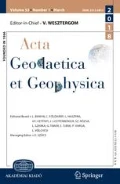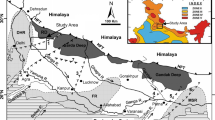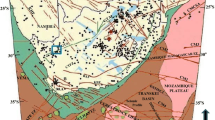Abstract
Burdur Fault (BF) is located in Fethiye Burdur Fault Zone and it has formed in three main sections as Gölbaşı–Gökçebağ, Burdur and Yassıgüme–Çendik. The Neogene Basin is a NE–SW oriented depression basin which forms Plio-Quaternary aged lacustrine and alluvial deposits. Paleo-seismic structures on lacustrine sediments were studied with three excavation surfaces at the BF segments in Burdur settlement area. The relationships between different paleo-seismic structures were explained in detail. Although we have obtained new data for the timing of past earthquakes, it is to determine the shear rate of BF segments. Lacustrine sediments and alluvium sequences showing clear evidence of the shearing movement effects were observed. Studies on slopes of foundation excavations on BF segments and near the segment were investigated. Stratified lacustrine sediments observed, each of consisting thin clay layers which is weakly developed in the marl unit excavation surfaces near the Gökçebağ segment. Thin layered lacustrine sediments developed that intersect with a parallel–parallel fractures that filled with collapsed sediments expose near the Burdur segment. In both excavation surfaces, the lower sedimentary unit is covered with a fine sand. The claystone and marl intercalations are discontinuous in the lateral direction and consist of alluvial and lacustrine deposits observed in excavation surfaces near the Yassıgüme–Çendik segment. This study emphasizes that the importance of geological structure has a significant impact on the formation of fault segments.









Similar content being viewed by others
References
Alçiçek MC, ten Veen JH, Özkul M (2006) Neotectonic development of the Çameli Basin, southwestern Anatolia, Turkey. In: Robertson AHF, Mountrakis D (eds) Tectonic development of the eastern mediterranean, vol 260. Geological, Society, London Special Publication, London, pp 591–611
Ambraseys NN, Jackson JA (1998) Faulting associated with historical and recent earthquakes in the Eastern Mediterranean region. Geophys J Int 33:390–406
Barka AA, Reilinger R (1997) Active tectonics of the Eastern Mediterranean region: deduced from GPS, neotectonic and seismicity data. Ann Geofis 40:587–610
Bozcu M, Yağmurlu F, Şentürk M (2007) Fethiye-Burdur fay zonunun bazı neotektonik ve paleosismolojik özellikleri. GB-Türkiye, Jeol Müh Der 31(1):25–48
Choi J-H, Kim Y-S, Choi S-J (2015) Identification of a suspected quaternary fault in eastern Korea: proposal for a paleoseismic research procedure for the mapping of active faults in Korea. J Asian Earth Sci 113:897–908
Dumont JF, Uysal S, Simsek S, Karamenderesi IH, Letokuzey J (1979) Güneybatı Anadoludaki grabenlerin olusumu. Maden Tetkik Arama Dergisi 92:7–17 (in Turkish)
Elitez İ, Yaltırak C, Aktuğ B (2016) Extensional and compressional regime driven left-lateral shear in southwestern Anatolia (eastern Mediterranean): the Burdur-Fethiye Shear Zone. Tectonophysics 688:26–35
Erdik M (2015) An overview of seismic hazard of Turkey. A scientific network for earthquake, landslide and flood hazard prevention. SciNetNatHazPrev-Stakeholders Meeting. November 13, 2015, Istanbul, Turkey. http://scinetnathaz.net/wp-content/uploads/2015/12/Seismic_Hazard_Erdik.pdf. Accessed 1 May 2019
Ertunç A, Karagüzel R, Yağmurlu F, Türker A, Keskin N (2001) Report of the investigation of Burdur municipality and nearby surroundings in reference to earthquakes and residential communities, Süleyman Demirel University, Isparta (unpublished, in Turkish)
Eyidoğan H (2019) Burdur-Fethiye Makaslama Zonu’nun içerisinde bir basen hareketi: 20 Mart 2019 Denizli, Acıpayam Depremi (Türkiye). http://temblor.net/earthquake-news/. Accessed 1 May 2019
Eyidoğan H, Barka A (1997) The 1 October 1995 Dinar Earthquake, SW Turkey. Terra Nova 8:479–485
Guidoboni E, Comastri A, Traina G (1994) Catalogue of ancient earthquakes in the Mediterranean area up to the 10th Century. Istituto Nazionale di Geofisica Pubblicazione, Rome
Hall J, Aksu AE, King H, Gogacz A, Yaltırak C, Çifçi G (2014) Miocene-Recent evolution of the western Antalya Basin and its linkage with the Isparta Angle, eastern Mediterranean. Mar Geol 349:1–23
Hançer M, Kaya Ş (2016) Burdur Fayının Çendik-Yassigüme segmenti üzerindeki Paleosismoloji çalışması ilk sonuçları. CBÜ Soma MYO Tekn Bil Der 21(1):12–26 (in Turkish)
Karabacak V (2011) Geological, geomorphological and archaeoseismological observations along the Cibyra fault and their implications for the regional tectonics of SW Turkey. Turk J Earth Sci 20:429–447. https://doi.org/10.3906/yer-0911-51
Kaymakçı N, Özacar A, Özkaptan M, Koç A, Gülyüz E, Lefebvre C, Uzel B, Langereis C, Sözbilir H (2014) Fethiye-Burdur Fault Zone: a myth? In: The 8th international symposium on eastern mediterranean geology (ISEMG-8). Muğla-Turkey, 13–17 October 2014, p 54
Kürçer A, Özdemir E, Uygun Güldoğan C, Duman TY (2016) The first paleoseismic trench data from Acipayam Fault, Fethiye Burdur Fault Zone, SW Turkey. Bull Geol Soc Greece L:75–84
McCalpin J (2009) Paleoseismology. Academic Press C, San Diego, p 613
McClusky SC, Balassanian S, Barka AA, Ergintav S, Georgie I, Gürkan O (2000) Global Positioning System constraints on plate kinematics and dynamics in the eastern Mediterranean Caucasus. J Geophys Res 105:5695–5719
Ministry of Development and Construction, Directorate of Disasters Research (TCIIB) (1971) 12.5.1971 Burdur earthquake report, Yayın No. 1, p 35, (in Turkish)
Ozbakir AD, Govers R, Wortel R (2017) Active faults in the Anatolian-Aegean plate boundary region with Nubia. Turk J Earth Sci 26:30–56
Ozcelik M (2016a) Optically stimulated luminescence (OSL) dating of quartz grains with in the sand dykes cutting the lacustrine deposits in the Burdur area (SW Turkey) and its tectonic interpretation. Arab J Geosci 9:21. https://doi.org/10.1007/s12517-015-2034-x
Ozcelik M (2016b) Evaluation of soft sediment deformation structures along the Fethiye Burdur Fault Zone, SW Turkey. J Earth Syst Sci 125(2):343–358
Ozkaptan M, Kaymakci N, Langereis CG, Gülyüz E, Ozacar AA, Uzel B, Sozbilir H (2018) Age and kinematics of the Burdur Basin: inferences for the existence of the Fethiye Burdur Fault Zone in SW Anatolia (Turkey). Tectonophysics 744:256–274. https://doi.org/10.1016/j.tecto.2018.07.009
Price PC, Scott B (1994) Fault-block rotations at the edge of a zone of continental extension, southwest Turkey. J Struct Geol 16:381–392
Reilinger R, McClusky S, Vernant P, Lawrence S, Ergintav S, Cakmak R, Ozener H, Kadirov F, Guliev I, Stepanyan R, Nadariya M, Hahubia G, Mahmoud S, Sakr K, ArRajehi A, Paradissis D, Al-Aydrus A, Prilepin M, Guseva T, Evren E, Dmitrotsa A, Filikov SV, Gomez F, Al-Ghazzi R, Karam G (2006) GPS constraints on continental deformation in the Africa-Arabia Eurasia continental collision zone and implications for the dynamics of plate interactions. J Geophys Res Solid Earth 111(B5):Art. No. B05411
Saroglu F, Emre O, Boray A (1987) Türkiye Diri Fayları ve Depremsellikleri, Maden Tetkik ve Arama Genel Müdürlüğü Jeoloji Etütleri Dairesi Rapor No:8174, Ankara. (in Turkish)
Taymaz T, Price SP (1992) The 1971 May 12 Burdur earthquake sequence, SW Turkey: a synthesis of seismological and geological observations. Geophys J Int 108:589–603
Temiz H, Poisson A, Andireux J, Barka A (1997) Kinematics of the plio-quaternary burdur-dinar cross-fault system in SW Anatolia (Turkey). Annales Tectonicae XI(1–2):102–113
Yağmurlu F, Bozcu M, Şentürk M (2008) Burdur-Fethiye arasındaki bölgede Burdur fayının sismotektonik özellikleri: Tübitak-ÇAYDAG, Project No. 101Y027, 79s. (unpublished report)
Acknowledgements
I would like to thank anonymous reviewers and the editorial board of the AGGE for their comments that helps to improve the content and quality of the paper. This research did not receive any specific grant from funding agencies in the public, commercial, or not-for-profit sectors.
Author information
Authors and Affiliations
Corresponding author
Rights and permissions
About this article
Cite this article
Ozcelik, M. Paleo-tectonic data evaluating from foundation excavations: a case study Burdur Fault segments (Turkey). Acta Geod Geophys 54, 545–556 (2019). https://doi.org/10.1007/s40328-019-00275-3
Received:
Accepted:
Published:
Issue Date:
DOI: https://doi.org/10.1007/s40328-019-00275-3




